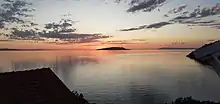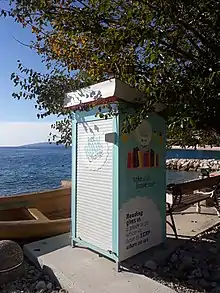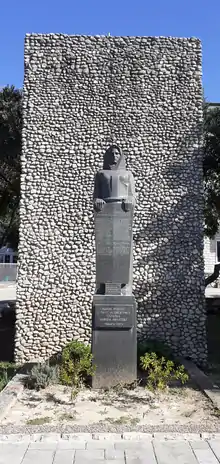Podaca
Podaca is a coastal village and tourist locality in southern Dalmatia, Croatia, half way between cities of Split and Dubrovnik, or more closely bigger towns of Makarska and Ploče, in the Gradac municipality, across from Pelješac peninsula and the famous Hvar (Pharos) island.


Podaca as a part of the Makarska littoral is completely oriented towards tourism (with minimum and limited olive agriculture). There were about 660 inhabitants (data from 2009 census) population of Podaca. The locality has about 1100 beds available in private rooms and suits, with ca. 183 accommodation units in the tourist resort Morenia[1] (renovated, extended and up-scaled in 2017 to 218) and about 600 accommodation units at the camping site "Uvala borova" (The pine bay). Well known for its beautiful beaches, peacefulness of the pinewood forests and the local cuisine that offers traditional Dalmatian gourmet spacials, together with a few daytrip attractive destinations, make Podaca a desirable place for family summer vacation. Unfortunately most of the facilities get closed and activities are reduced as early as October and only re-activate in May or some even only with the start of June. As of 90s there has been a trend of older population from neighboring regions (mostly Bosnia & Herzegovina) retiring to live in this area, hence extending the use of summer vacation houses. However many of the local youth are leaving the area for work since Croatia joined EU.
After many years of decay (since the war in early 90s) first significant infrastructural development was done only since 2017, which includes establishing and fixing pathways and building playground for kids and open air sport courts, as a signs of better governance with change of local political climate. Medical emergency point has been established in 2017[2] the former building of supermarket "Razvitak" (now also post office) to serve near by villages and towns. Establishing of innovative mini cultural outpost in the form of "beach library"[3] became a good sign of potential for future. Through European Union subsidy most basic free WiFi hotspots were installed in place in the center of Podaca (next to bus stop) and Viskovića Vala beach area (as is in neighboring villages/towns).[4]

Due to new A1 highway of Croatia from Zagreb to Ploče (with no exits close by) and also the change of the bus-business operations (Flixbus reduced bus stops), Podaca and most of smaller towns and villages became significantly less accessible by public transport. Buses are only options, but few are available in daytime and rare later in the day from Dubrovnik and Split, while Makarska and Ploče also not later in the evenings and early night.
History

Podaca village was initially located up the hill, but since 60s along the coast, divided in three neighborhoods that are seamlessly connected to next willages: Kapeć (bordering Zaostrog), Viskovića vala and Ravanje (bordering Brist).
Old Podaca was founded on the rocky slopes as defensible location, and there are traces of human habitation since Stone Age, like a stone mallet for mixing grain, which is kept in a Franciscan monastery at Zaostrog. Many stone ruins beneath Biokovo bear witness to the period of Illyrian habitation (2000 years BC - 1st century).
During the Roman rule this area was administrated from Narona. There are many artifacts from that period like a broken jar with a silver coin with a Roman emperor Sever (193-211AD), which were found here. Other remains from the Roman age include a part of the walls, near which a Christian tone tablet was found, dated from the Middle Ages. During the Large migrations Croats inhabited these parts (7th - 8th century). They founded their settlements high on the hilltops, in order to have a more defensible position and to make use of mountain pastures.
The Middle Ages were marked with a constant struggle between Croats and Venetians. Croats were at the peak of their naval might during the dominance of Kacic dynasty, with their decline (1280) Croatian naval dominance also declined. One of the remains from that period (11th-12th century) is an old Croatian church of St. Ivan with tombs of Kacic family at Gornja Podaca, which were Kacic ancestral lands. The church of St. Ivan at the Podaca cemetery was built in pre-Romanesque period in the 11th and 12th centuries. Not far from the church of St. Ivan, built in 1492, stood the church of St. Stjepan, which was razed to the ground in the 18th century to make room for a present-day church built in 1762. After an earthquake in 1962, almost the entire population migrated to the coastal area where a new church was built to Our Lady of Annunciation. Near the church there lies a cemetery with ancient tombstones.
During the World War 2 many of the people of Podaca were killed fighting Fascism or as victim of the regime. Sculptor Luka Musulin (student of famous Antun Augustinčić) made and gave as a present to his birthplace[5] an impressive larger than life size sculpture in dark granite of Dalmatian mother holding a list with their names.
References
- https://morenia.com.hr/o-kompaniji.php
- "U Podacima kod Makarske otvorena ispostava Hitne medicinske službe". Dalmacija News. 2017-05-03. Retrieved 2020-09-28.
- https://gradac.hr/en/news/plazna-biblioteka
- "Općina Gradac - WIFI4EU". opcinagradac.hr. Retrieved 2020-09-28.
- https://www.spomenikdatabase.org/zaostrog
